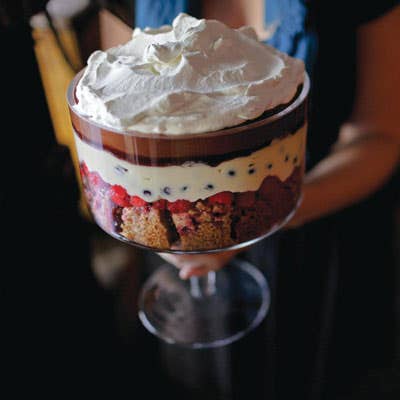
Eat, Drink, and be Merry: A New Year’s Feast in Somerset
A New Year’s Eve party in the English Countryside marks the culmination of winter’s feasting season.
My friends and I are standing on the doorstep looking out at the corona haloing the moon, a blue moon, which means it's the second full one this month; more than that, it's only the second New Year's Eve blue moon in two decades. There isn't a sound until a firework zooms up into the black yonder, and in the distance, over the Quantock Hills, there are fountains of pink and gold and green. We pop the champagne corks and bay at the moon.
Every year I throw a New Year's Eve party at my house in rural Somerset, in the southwest of England. The number of guests usually hits just above the two-dozen mark, though tonight numbers 25 and 26 are snowed in up in Derbyshire and are sending frantic texts about how they've only got a tin of baked beans and a packet of sausages, the digger can't reach them, and what a cruel fate theirs is compared with ours. This year the oldest guest is an octogenarian and the youngest is 14. The party games are organized by a local friend my children call the Real James Bond, as well he might be with his balding but chic velvet smoking jacket and a history of derring-do in the Special Air Service that we'll never quite get to the bottom of for reasons of official secrecy.
Usually I have no idea what I am going to cook until just before the day arrives; I'm too busy with the planning and executing of Christmas and the feasting days following it. One year I reserved the Christmas ham for the New Year's meal and served it with the customary Cumberland sauce made with red currant jelly and port—a jolly old British tradition, but, really, my competitive desire to surprise and delight even the most jaded of palates after a whole week's feasting knows no bounds. I have served everything from a Moroccan tagging to chicken Savoyarde bathed in cream from local Jersey cows, white wine, Comte cheese, Dijon mustard, and tarragon. This season starts and ends with feasting.
My one proviso is to make a dish that can be prepared in advance so the work on the night of the party is minimal. This year I decide that what we need is robust flavor, something fragrant, but nothing overly ambitious; the guests will welcome a dish that's fresh, lively, and light after the excesses of Christmas. I settle on _[murgh makhanwala](
Probably best, anyway, in his condition, that he won't be here for dessert. In England, it is traditional to present a liquor-drenched trifle at some stage of the festive proceedings; as with all national dishes, there are as many versions as there are cooks. In the wrong hands this 16th-century masterpiece has descended into farce: stale cake drowned in inferior sherry and topped with layers of Day-Glo red gelatin, shop-bought gloopy custard, and lashings of cream whipped rigid. It took me years to discover what real trifle is: a glorious thing composed of homemade cake and custard, fresh fruit, and a billowy topping of sherry-laced syllabub. This year, in the week after Christmas, I've experimented with a new version; the first attempt won the children's approval, but what about a name? My son, Harry, came up with it instantly: [Decadent Trifle](
Keep Reading
Continue to Next Story










